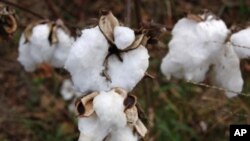A United Nations Trade Group is promoting so-called "EcoChic Fashion" as one way of stemming the rapid loss of the world's biodiversity. The United Nations has designated 2010 as the International Year of Biodiversity to focus attention on the threatened extinction of the fauna and flora on which the world depends for survival. The U.N. Conference on Trade and Development is calling for the sustainable use of natural resources. It says ecological fashion firms use organic materials and production methods that do not damage the environment.
Pencil-thin models strut down the catwalk sporting the latest in ecochic fashion. With their stiletto heels and robotic looks, they could be in Milan or Paris, London or New York. But, their flaxen beehive wigs and stylish garments made from natural materials tell a different story. Nearly 50 ready-to-wear and couture designers from 40 countries have cut their cloth from a range of organic and recyclable materials including organic bamboo and silk, alpaca and pineapple fibers and even 100 percent paper.
The organizer of the show, Christina Dean, says her Hong Kong-based environmental charity, Green2Greener, promotes sustainable living. She says ecochic events are the main platform for doing that.
"We always try to ensure that we really are doing the best we can in our environmental performance. Obviously, with a very strong message about fashion and sustainability, we need to be as sensitive to the environment in everything that we do," she says.
"I embarked on the road of sustainability or ethics or biodiversity about five years ago, when I founded a company called Noir…I work with 16,000 farmers in Africa. And, what we do is grow organic and fair-traded cotton," says Danish fashion designer Peter Ingwersen, who says he got into so-called "green fashion" when he realized more and more consumers nowadays want to buy ethically. They want to be seen to be doing good.
"Ten years ago, it was enough to buy the latest 'it' bag. Today, that is not enough any more," he says. "When you want to buy the latest it bag, you also want to know how it is produced…And that is the biggest change that we have seen in our business since the hem-lengths went below the knee."
Conservationists present a gloomy picture about the state of the world's biodiversity. The United Nations reports the loss of habitat has accelerated the loss of biodiversity in recent years. Some estimates suggest species extinction because of human activity is about 1,000 times faster than the natural rate of loss.
Bio-trade analyst at the U.N. Conference on Trade and Development Lucas Assuncao says local communities will be more inclined to preserve their flora and fauna, if they can see economic benefits from using their natural resources in a sustainable manner.
He says this has worked in Bolivia, which has a huge population of yacare, a species of crocodile.
"It so happens that in some parts of Bolivia, this over-population of yacares is detrimental to human life…So, there is a real claim there to sustainably manage the yacare population, which means killing them. It so happens that the skin is very valuable for the shoe industries in Italy, for example. So, there is a win-win opportunity," he says.
"My name is Sarah, Sarah Ratty. I run an eco-fashion brand called Ciel. I've been involved in eco-fashion for 20 years." Ratty says ecologically friendly clothes are not, necessarily, ethnic nor frumpy looking. She says her collection is very modern, although it uses a diverse range of natural products.
"There are a lot of great new green innovations, which are working within natural fabrics, as well as synthetics that are doing this," she says.
"I am Alphadi. I'm the president of all-Africa Fashion Designers for 20 years." Alphadi, who comes from Niger, is founder of the Festival of the Deserts. "I make every two years a big festival in the desert. We bring maybe 5,000 persons to the desert to make African fashion true and to help African fashion to grow and to give human face for African fashion."
Alphadi has stores in New York, Paris and several African countries. His clients include the wives of Africa's presidents. He has designed clothes for U.S. Secretary of State Hillary Clinton and the late singer Michael Jackson.
Alphadi says promoting so-called green clothes is both good for the environment and good for the pocketbook. His ecochic couture fashion costs several thousands of dollars and, ready to wear, several hundred dollars.
"That's me. Alphadi. Eco. Green and we make money. Make money for me and make money for my country. And to help Africa to grow and to give it a human face…Europeans make fashion. Why not Africa? Fashion can help Africa."
The show is over. And, from the enthusiastic applause, it is clear that, at least with this crowd, ecochic is in. The U.N. Conference on Trade and Development says eco-fashion brings in between $150 million and $200 million a year.
It considers this an increasingly significant chunk of the market and predicts green fashion will continue to grow, as more people recognize that what is good for the environment can also be good for their looks.





